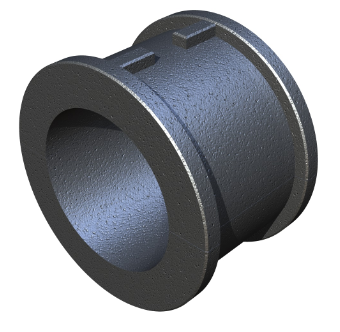What Is Hard Iron?
Hard iron is an iron which is not readily magnetized by induction but which retains a high percentage of the magnetism acquired. When a bar of non-magnetized iron is placed in magnetic field, the direction of magnetization of the magnetic domains tends to move towards the direction of the field. This makes the domains aligned with the direction of the magnetic field. In hard iron, the shifting of these magnetic domains is irreversible. In other words, the magnetic domains of hard iron do not return to the starting point when magnetic field is removed.

Applications Of Soft Iron
- Industrial: Lifting apparatus, robotics, meters
- Biosurgical: NMR/MRI body Scanner
- Consumer Electronics: Clocks, DC motor for showers
- Data Processing: Printers, Stepping Motors, Disc Drives and actuators
- Telecommunication: microphones, loud speakers, telephone ringers.
What You Need To Know About Hard Iron
- Hard iron is an iron which retains their magnetism and is difficult to magnetize.
- Hard irons are also referred to as hard magnetic materials.
- Hard irons retain their magnetism even after the removal of the applied magnetic field.
- Hard iron has large hysteresis loss due to large hysteresis loop area.
- Susceptibility and permeability are low. Permeability is used to determine how a material reacts to the applied magnetic field.
- It can be produced by heating and sudden cooling.
- Coercivity and retentivity values are large. Coercivity is the capability of a ferromagnetic material to hold up (resist) a peripheral magnetic field without getting demagnetized whereas retentivity (Br) is the amount of magnetism that a ferromagnetic material can maintain even after the magnetic field is decreased to zero.
- Domain wall does not move easily and require large value of BH product for magnetization.
- Magnetic energy stored is high.
- Hard iron is used in making permanent magnets because it has high retentivity and coercivity. They are also used in electric motor, generator, transformer, relays, telephone receivers, radar etc.
- The eddy current loss is high due its low resistivity.
- Hard iron cannot be easily demagnetized.
What Is Soft Iron?
Soft iron is iron that has low carbon content and is easily magnetized and demagnetized. It is used to make the cores of solenoids and other electrical equipments.
When a bar of non-magnetized iron is placed in a magnetic field, the magnetic domains shifted towards the direction of a magnetic field can be shifted back to the initial state. In soft iron, shifting of domains is reversible, but the returned magnetic domain will align in a random manner. In other words, the magnetic domains of hard iron do return to the starting point when magnetic field is removed.

Applications Of Soft Iron
- Used in field of magnetic shielding
- It is used to make the cores of solenoids and other electrical equipments.
- It is also used in loud speakers and electrical measuring instruments.
- It is used for making temporary magnets.
What You Need To Know About Soft Iron
- Soft iron is iron that is easily magnetized and demagnetized with a small change of magnetic field.
- Soft iron is also referred to as soft magnetic materials.
- Soft iron does not retain their magnetism even after the removal of the applied magnetic field.
- Soft iron has low hysteresis loss due to small hysteresis area.
- Susceptibility and permeability are high.
- It can be produced by heating and slow cooling.
- Coercivity and retentivity values are less.
- Domain wall move easily and requires small value of BH product for magnetization.
- Magnetic energy stored is less.
- Since it has low retentivity and coercivity, it is not used for making permanent magnets. It is used for making temporary magnets. It is also used in loud speakers and electrical measuring instruments.
- The eddy current loss is less because of high resistivity.
- Soft iron can be demagnetized easily.
Difference Between Hard Iron And Soft Iron In Tabular Form
| BASIS OF COMPARISON | HARD IRON | SOFT IRON |
| Description | Hard iron is an iron which retains their magnetism and is difficult to magnetize. | Soft iron is iron that is easily magnetized and demagnetized with a small change of magnetic field. |
| Alternative Name | Hard irons are also referred to as hard magnetic materials. | Soft iron is also referred to as soft magnetic materials. |
| Magnetism Retention | Hard irons retain their magnetism even after the removal of the applied magnetic field. | Soft iron does not retain their magnetism even after the removal of the applied magnetic field. |
| Hysteresis Loss | Hard iron has large hysteresis loss due to large hysteresis loop area. | Soft iron has low hysteresis loss due to small hysteresis area. |
| Susceptibility | Susceptibility and permeability are low | Susceptibility and permeability are high. |
| Production | It can be produced by heating and sudden cooling. | It can be produced by heating and slow cooling. |
| Coercivity And Retentivity | Coercivity and retentivity values are large | Coercivity and retentivity values are less. |
| BH Products | Domain wall does not move easily and require large value of BH product for magnetization. | Domain wall move easily and requires small value of BH product for magnetization. |
| Magnetic Energy | Magnetic energy stored is high. | Magnetic energy stored is less. |
| Application | It used in making permanent magnets. | It is used for making temporary magnets. |
| Eddy Current | The eddy current loss is high due its low resistivity. | The eddy current loss is less because of high resistivity. |
| Demagnetization | Hard iron cannot be easily demagnetized. | Soft iron can be demagnetized easily. |